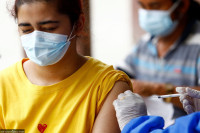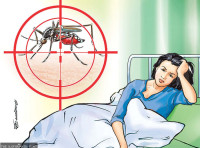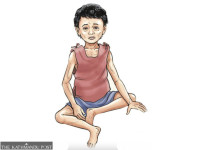Health
Foreign aid cut causes sharp drop in HIV testing in Nepal
USAID gone and Global Fund grants delayed, vulnerable groups at high risk of HIV, experts warn.
Arjun Poudel
HIV testing in Nepal declined alarmingly in the first half of 2025, a drop that experts say could reverse years of progress against the disease.
According to data from the National Center for AIDS and STD Control under the Department of Health Services, 214,722 people underwent HIV testing from January to June this year, compared to 325,514 in the same period in 2024.
With the decline in testing, new case detection has fallen proportionally. The data show 1,024 new cases were detected until June this year, compared to 1,575 new cases of HIV infection during the same period last year.
What alarms experts is that testing has not only declined in the general population but has also stopped among high-risk groups—female sex workers, men having sex with men, transgender and other vulnerable populations.
“Due to delays in the allocation of budget from the Global Fund and the suspension of USAID funding, testing of key vulnerable populations has been halted since January,” said Lok Raj Pandey, information officer at the National Center for AIDS and STD Control. “The main reason for the decline in HIV testing is the lack of funds, and funding has not yet resumed.”
Experts warn that the decline in testing could lead to a massive spread of the deadly disease. They warn that years of progress in HIV control achieved through huge investments could be jeopardised if testing is not resumed among key vulnerable populations.
“If the testing is reduced, we cannot identify infections,” said Dr Anup Bastola, chief consultant of tropical medicine.“Even after infection, a person may remain asymptomatic for seven to 10 years and he/she could still transmit the virus.”
Studies show, one in every five HIV-infected people is unaware of their status.
Experts say the decline in new case detection is an obvious result of the decline in testing.
They, however, warn that this trend is serious and could prove too costly for the country.
“Testing helps in new case detection, which helps start treatment early meaning that complications including severity and deaths will be lessened,” said Bastola. “Early detection also helps protect family members from infection and allows those infected to live normal, healthier lives.”
Health officials admit that alongside the decline in testing thousands of female sex workers, gay men, and people taking injectable drugs have been deprived of pre-exposure prophylaxis since USAID-funded programmes were suspended in January.
Pre-exposure prophylaxis is a medicine that people at risk for HIV take to prevent infection from unprotected sex or injectable drug use. The Ministry of Health and Population does not have its own preventive programmes. As a result, hundreds of at-risk people, including pregnant women whose husbands are HIV-positive, have been deprived of the medicine.
The abrupt suspension of USAID-funded programmes also disrupted awareness campaigns targeting female sex workers, homosexual men, and other high-risk groups, community testing of HIV, behavioural-change initiatives, and other targeted interventions have also been halted indefinitely.
“We don’t have a budget for targeted intervention programmes,” said Pandey. “The budget allocated by the government is sufficient only for antiretroviral medicine and testing at government centres.”
It is estimated that in 2024, a total of 34,337 people were living with HIV in Nepal, 4,037 more than in 2023.




 7.12°C Kathmandu
7.12°C Kathmandu














